-
Table of Contents
- How to Deal with Back to School Anxiety in Children
- Understanding Back to School Anxiety
- Recognizing Signs of Anxiety
- Practical Strategies for Parents
- 1. Open Communication
- 2. Establish a Routine
- 3. Visit the School
- 4. Role-Playing
- 5.
. Encourage Positive Thinking
- Seeking Professional Help
- Conclusion
How to Deal with Back to School Anxiety in Children
As summer winds down and the school year approaches, many children experience a surge of anxiety. This phenomenon, often referred to as “back to school anxiety,” can manifest in various ways, from physical symptoms like stomachaches to emotional responses such as irritability or withdrawal. Understanding how to effectively manage this anxiety is crucial for both parents and children. This article will explore practical strategies to help children cope with their back-to-school jitters.
Understanding Back to School Anxiety
Back to school anxiety is a common issue that affects many children, regardless of age. According to a survey conducted by the National Institute of Mental Health, approximately 30% of children report feeling anxious about returning to school. This anxiety can stem from various sources, including:
- Fear of the unknown: New teachers, classmates, and school environments can be intimidating.
- Academic pressure: Concerns about grades and performance can weigh heavily on young minds.
- Social dynamics: Navigating friendships and peer relationships can be challenging.
- Separation anxiety: Younger children may struggle with being away from their parents.
Recognizing Signs of Anxiety
Before addressing back to school anxiety, it’s essential to recognize its signs. Common indicators include:
- Physical symptoms: Headaches, stomachaches, or fatigue.
- Emotional changes: Increased irritability, sadness, or withdrawal from activities.
- Behavioral shifts: Changes in sleep patterns, appetite, or school performance.
Practical Strategies for Parents
Parents play a crucial role in helping their children navigate back to school anxiety. Here are some effective strategies:
1. Open Communication
Encourage your child to express their feelings about returning to school. Ask open-ended questions to facilitate discussion, such as:
- What are you most excited about this school year?
- What worries you the most about going back to school?
Listening without judgment can help children feel understood and supported.
2. Establish a Routine
Creating a consistent daily routine can provide a sense of stability. Gradually reintroduce school-related activities, such as:
- Setting a regular bedtime and wake-up time.
- Designating time for homework and study.
- Incorporating relaxation techniques, such as deep breathing or mindfulness exercises.
3. Visit the School
If possible, take your child to visit their school before the first day. Familiarizing them with the environment can alleviate anxiety. Walk through the hallways, locate their classroom, and meet the teacher if possible.
4. Role-Playing
Engage in role-playing scenarios to help your child practice social interactions. This can include:
- Introducing themselves to new classmates.
- Asking a teacher for help.
- Handling potential conflicts with peers.
5. Encourage Positive Thinking
Help your child reframe negative thoughts into positive affirmations. For example, instead of thinking, “I will fail my math test,” encourage them to say, “I will do my best and learn from my mistakes.”
Seeking Professional Help
If your child’s anxiety persists or worsens, consider seeking help from a mental health professional. Cognitive-behavioral therapy (CBT) has proven effective in treating anxiety disorders in children. According to the American Psychological Association, CBT can help children develop coping strategies and change negative thought patterns.
Conclusion
Back to school anxiety is a common challenge that many children face as they transition from summer to the school year. By recognizing the signs of anxiety and implementing practical strategies, parents can help their children navigate this stressful time. Open communication, establishing routines, familiarizing children with their school environment, and encouraging positive thinking are all effective ways to support anxious children. If anxiety persists, seeking professional help can provide additional support. Remember, with the right tools and understanding, children can overcome their fears and embrace the new school year with confidence.
For more resources on managing anxiety in children, visit NAMI.





